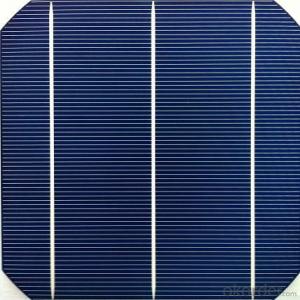Manufactured 120w Single Monocrystalline solar cells
- Loading Port:
- China Main Port
- Payment Terms:
- TT OR LC
- Min Order Qty:
- -
- Supply Capability:
- -
OKorder Service Pledge
OKorder Financial Service
You Might Also Like
Quick Details
| Model Number: | |||||
| Material: | Size: | Number of Cells: | |||
| Max. Power: | warranty: | Pmax: | |||
| Vmp: | Imp: | Voc: | |||
| Isc: | package: | customized: |
Packaging & Delivery
| Packaging Detail: | 1. packed by carton inside, and wooden case outside 2. 2 pieces into a carton |
| Delivery Detail: | 10 to 30 days according to the quantity |
Specifications
1.manufactured 120w single monocrystalline solar cells
2.CE passed
3.Size:1361*670*35mm
4.Number of Cells:36 (4*9)
manufactured 120w single monocrystalline solar cells
Reference Picture | Item : | Specification |
| Maximum power at STC(Pmax) | 120W |
| Optimum operating voltage(Vmp) | 17.2V |
| Optimum operating current(Imp) | 6.98A |
| Open-circuit voltage(Voc) | 21.6V |
| Short-circuit current(Isc) | 7.72A |
| Short-circuit current temperature coefficient | (0.065±0.015)%/°C |
| Open-circuit voltage temperature coefficient | -(80±10)mV/°C |
| Peak power temperature coefficient | -(0.5±0.05)%/°C |
| NOCT (Air 20°C; Sun 0.8kW/m wind 1m/s) | 47±2°C |
| Operating temperature | -40°C to 85°C |
| Maximum system voltage | 600V DC |
Cell | Power tolerance | No. of cell and connection |
mono-crystalline silicon solar cells | ±3% | 36(4×9) |
Dimension of module | Weight | Electrical Characteristics |
1161mm×670mm×35mm | 10.5kg | YHSP120-12 |
Characteristics | Dimension | |
- Q: Can solar cells be used in water desalination?
- Yes, solar cells can be used in water desalination. Solar energy can be harnessed by solar cells to power desalination processes such as reverse osmosis or distillation, providing a sustainable and renewable source of energy for converting saltwater into freshwater.
- Q: Can solar cells be used to power communication systems?
- Yes, solar cells can be used to power communication systems. Solar cells are capable of converting sunlight into electricity, which can then be used to power various electronic devices, including communication systems. This is particularly advantageous in remote or off-grid areas where it may be difficult or expensive to establish traditional power infrastructure. Additionally, solar-powered communication systems offer a sustainable and environmentally friendly alternative to relying solely on fossil fuels for energy.
- Q: Can solar cells be used in remote sensing devices?
- Yes, solar cells can be used in remote sensing devices. Solar cells are capable of converting sunlight into electricity, making them an ideal power source for remote sensing devices that require continuous operation in areas where traditional power sources are unavailable or impractical to use.
- Q: What is the payback period for installing solar cells?
- The payback period for installing solar cells varies depending on several factors such as the initial cost of the installation, the amount of energy generated, and the cost of electricity. On average, it typically takes between 5 to 10 years for solar cells to recoup their initial investment through energy savings.
- Q: Can solar cells be used for powering communication systems?
- Yes, solar cells can be used to power communication systems. Solar cells convert sunlight into electrical energy, which can then be used to power various electronic devices, including communication systems. This renewable source of energy is a sustainable and environmentally friendly option for powering communication systems, especially in remote or off-grid locations where access to traditional power sources may be limited.
- Q: What are the applications of solar cells?
- communication / communication field: solar unattended microwave relay station, optical cable maintenance station, radio / communication / paging power system; rural carrier telephone photovoltaic system, small communication machine, soldiers GPS power supply.
- Q: Where can I buy solar cells?
- Why do you want to buy solar cells?
- Q: Can solar cells be used in floating solar farms?
- Yes, solar cells can be used in floating solar farms. In fact, floating solar farms have gained popularity as an innovative solution to maximize energy production in areas with limited land availability. These floating platforms are equipped with solar panels, which convert sunlight into electricity, just like traditional solar farms. The buoyant structures allow for the installation of solar panels on water bodies such as lakes, reservoirs, and even oceans, making it an efficient way to harness solar energy while minimizing land use.
- Q: How are solar cells used in military applications?
- Solar cells are used in military applications to power portable electronic devices, remote surveillance systems, and even to provide electricity to military bases in remote locations. They offer a reliable and sustainable source of power, reducing the need for fuel resupply and minimizing the environmental impact. Additionally, solar cells can be integrated into various military equipment, such as backpacks and helmets, enabling soldiers to generate power on the move.
- Q: Can solar cells be used in powering RVs and campers?
- Yes, solar cells can be used to power RVs and campers. Solar panels can be installed on the roof of the vehicle to capture sunlight and convert it into electrical energy, which can then be used to power various appliances and systems in the RV or camper. This provides a clean and sustainable source of power, especially when camping in remote areas where access to electricity may be limited.
Send your message to us
Manufactured 120w Single Monocrystalline solar cells
- Loading Port:
- China Main Port
- Payment Terms:
- TT OR LC
- Min Order Qty:
- -
- Supply Capability:
- -
OKorder Service Pledge
OKorder Financial Service
Similar products
Hot products
Hot Searches
Related keywords
























